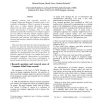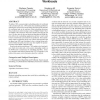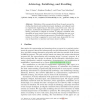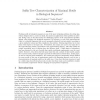939 search results - page 155 / 188 » A Case for Polyscopic Structuring of Information |
HICSS
1994
IEEE
14 years 26 days ago
1994
IEEE
Meeting research and especially research on Computer Supported Meetings of natural teams is not available in abundance. What is reported of meetings often uses a rather limited th...
CPM
1993
Springer
14 years 25 days ago
1993
Springer
It is widely accepted that the optimal alignment between a pair of proteins or nucleic acid sequences that minimizes the edit distance may not necessarily re
ect the correct biolog...
SIGMETRICS
2010
ACM
14 years 20 days ago
2010
ACM
We define CWS, a non-preemptive scheduling policy for workloads with correlated job sizes. CWS tackles the scheduling problem by inferring the expected sizes of upcoming jobs bas...
ER
2007
Springer
14 years 19 days ago
2007
Springer
Abstract. Definitions of the concepts derived from the goal concept (including functional and nonfunctional goal, hardgoal, and softgoal) used in requirements engineering are discu...
BIRD
2008
Springer
13 years 10 months ago
2008
Springer
Finding motifs in biological sequences is one of the most intriguing problems for string algorithms designers due to, on the one hand, the numerous applications of this problem in...




